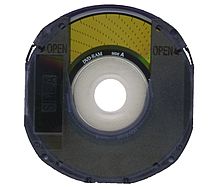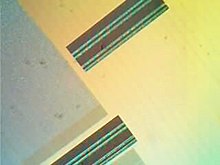|
DVD-RAM
DVD-RAM (DVD Random Access Memory) is a DVD-based disc specification presented in 1996 by the DVD Forum, which specifies rewritable DVD-RAM media and the appropriate DVD writers. DVD-RAM media have been used in computers as well as camcorders and personal video recorders since 1998.[1] In May 2019, Panasonic, the only remaining manufacturer of DVD-RAM discs, announced that it would end production of DVD-RAM media by the end of that month, citing shrinking demand as the primary motivation.[2] Panasonic made these discs under its own brand name and also under the Verbatim brand. The "RAM" in its name is not related to random-access memory (also named "system memory" or "computer memory") that computers use to store opened programs, a much different technology. FormatDVD-RAM works by means of phase change technology which was chosen instead of magneto-optical technology (an already existing rewritable solution at the time) because it doesn't require a magnetic head and therefore it represented reduced complexity and costs. Phase change technology uses laser light to heat the surface of a phase changing alloy and allows it to go from a crystalline to an amorphous state and vice versa, therefore altering its optical reflectivity index. To change the recording material from a crystalline to an amorphous state, and back again a high or medium power laser light is used to control the rate of cooling of the phase changing alloy therefore establishing the final state. Encoding is done by means of difference in reflectivity of the alloy, a laser is pointed at the surface and the returned intensity signifies either a 1 or a 0.[3] DVD-RAM uses concentric tracks each divided into hard (factory originated) sectors, in contrast to traditional spiral recording found in other DVD and CD formats. A 12 cm (5") 4.7 GB disc is divided into 35 zones of tracks, with each zone having more sectors per track compared to the previous zone. This makes its data structuring very similar to that of hard drives and floppy disks. This means that usually DVD-RAMs are suitable to be accessed by the OS without any special software [4] SpecificationRecording speedsSince the Internationale Funkausstellung Berlin 2003 the specification is being marketed by the RAM Promotion Group (RAMPRG), built by Hitachi, Toshiba, Maxell, LG Electronics, Matsushita/Panasonic, Samsung, Lite-On and Teac. The specification distinguishes between:
Speeds more than 2x are defined by Optional Specifications (Nx-speed DVD-RAM):[6][8]
DiametersDVD-RAM discs can have 12 or 8 cm in diameter, around 5 or 3 inches respectively. The latter variant is mainly intended for camcorders that use DVD as storage media and also exists with capacities of 1.46 GB for a single-sided disc, 2.8 GB for a double-sided disc, and 5.6 GB for a dual-layer double sided disc, however, they are relatively uncommon. DVD-RAMs were originally solely sold in disc caddy cartridges; recent DVD recorders can work with discs either with or without a cartridge, and many devices do not work with cartridges. Discs can be removed from cartridges for use with these drives (except with type 1 media, see table above). Cartridge types
Compatibility Many operating systems like the classic Mac OS (from Mac OS 8.6 up), macOS, Linux, and Microsoft Windows XP can use DVD-RAM directly, while earlier versions of Windows require separate device drivers or the program InCD. Windows XP can only write directly to FAT32 formatted DVD-RAM discs. For UDF formatted discs, which are considered faster,[by whom?] a third-party UDF file system driver capable of writing or software such as InCD or DLA are required. Windows Vista and later can natively access and write to both FAT32 and UDF formatted DVD-RAM discs using mastered burning method or packet writing. Even though it is possible to use any file system one likes, very few perform well on DVD-RAM. This is because some file systems frequently overwrite data on the disc and the table of contents is contained at the start of the disc. Windows Vista (and later) implement the CPRM data protection and thus discs formatted under Windows XP (or earlier) have compatibility issues with Vista onwards (and vice versa). The classic Mac OS up to 9.2 can read and write HFS, HFS+, FAT, and UDF formatted DVD-RAM discs directly. In Mac OS X (versions 10.0.x through 10.4.x) UDF-formatting of DVD-RAM is no longer supported, instead formatting and writing DVD-RAM is done in HFS+ format. (UDF support was re-implemented in 10.5 Leopard) (HFS and UFS should also be supported on older versions of Mac OS X that retain support for these file systems.)[10][11] Many DVD standalone players and recorders do not work with DVD-RAM. However, within "RAMPRG" (the DVD-RAM Promotion Group consisting of Hitachi, Toshiba, Maxell, LG Electronics, Matsushita/Panasonic, Samsung, Lite-On, Teac) there were a number of well-known manufacturers of standalone players, recorders, and camcorders that could use DVD-RAM. Panasonic, for instance, had a range of players and recorders which made full use of the advantages of DVD-RAM. The last DVD-RAM Specification, DVD-RAM2 (also called RAM2 or Class 1), is not compatible with DVD drives that do not specifically allow reading DVD-RAM2 discs.[12] DVD-RAM2 medium was brought to the market in Japan,[13][14] but was not launched worldwide.[15] Some high end products such as IBM System p mainframes require DVD-RAM instead of DVD-RW.[16] Many half-height DVD Multi Recorder drives released between 2006 and 2010, including the TSSTcorp SH-S182/S183 (2006) and SH-S203/TS-H653B (2007) have officially adapted support for 12× DVD-RAM speeds, while more recent DVD writers such as the SH-224DB (2013) and Blu-ray writers such as the LG BE16NU50 (2016) have restricted the supported DVD-RAM writing speed to 5×.[17][18] The Nintendo Wii U can use DVD-RAM for extended storage over USB.[19][20] Advantages  
Disadvantages
See also
References
Books
External linksWikimedia Commons has media related to DVD. |
|||||||||||||||||||||||||||||||||||||||||||||||||||||||||||||||||||



